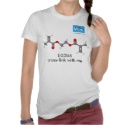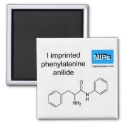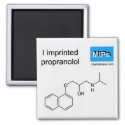|
|
Reference type: Journal
Authors: Baggiani C, Baravalle P, Giovannoli C, Anfossi L, Passini C, Giraudi G
Article Title: Binding behaviour of molecularly imprinted polymers prepared by a hierarchical approach in mesoporous silica beads of varying porosity.
Publication date: 2011
Journal: Journal of Chromatography A
Volume: 1218
Issue: (14)
Page numbers: 1828-1834.
DOI: 10.1016/j.chroma.2011.02.003
Alternative URL: http://www.sciencedirect.com/science/article/B6TG8-524N9FD-2/2/fb65bf61b76a42c6957a5fbf0da547b8
Abstract: One of the most interesting methods for preparing molecularly imprinted polymers with controlled morphology consists in filling the pores of silica beads with an imprinting mixture, polymerizing it and dissolving the support, leaving porous imprinted beads that are the "negative image" of the silica beads. The main advantage of such an approach consists in the easy preparation of spherical imprinted polymeric particles with narrow diameter and pore size distribution, particularly indicated for chromatographic applications. In this approach it has been shown that the resulting morphology of polymeric beads depends essentially on the porosity and surface properties of the silica beads that act as microreactors for the thermopolymerization process. Anyway, it is not yet clear if the porosity of the silica beads influences the binding properties of the resulting imprinted beads. In this paper, we report the effect of different porosities of the starting mesoporous silica beads on the resulting binding properties of imprinted polymers with molecular recognition properties towards the fungicide carbendazim. The morphological properties of the imprinted beads prepared through this hierarchical approach were measured by nitrogen adsorption porosimetry and compared with a reference imprinted material prepared by bulk polymerization. The chromatographic behaviour of HPLC columns packed with the imprinted materials were examined by eluting increasing amounts of carbendazim and extracting the binding parameters through a peak profiling approach. The experimental results obtained show that the resulting binding properties of the imprinted beads are strongly affected by the polymerization approach used but not by the initial porosity of the silica beads, with the sole exception of the binding site density, which appears to be inversely proportional to them
Template and target information: carbendazim
Author keywords: molecular imprinting, Silica beads, Bulk polymerization, Non linear chromatography, Peak profiling, affinity constant, Binding site concentration, Rate constant
|


 cross-link with me ball and stick shirt
cross-link with me ball and stick shirt







 I imprinted phenylalanine anilide magnet
I imprinted phenylalanine anilide magnet







 I imprinted propranolol magnet
I imprinted propranolol magnet






